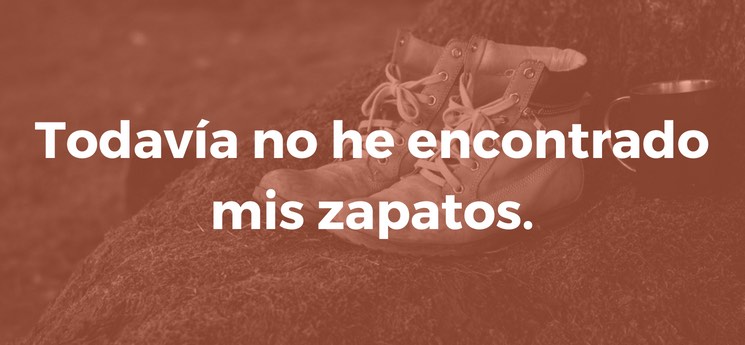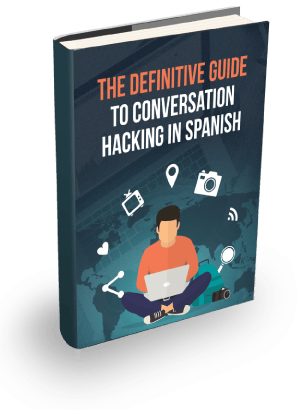If you want to talk about your expectations for events in the past or present, then ya and todavía are incredibly useful.
These two Spanish adverbs allow you to tell someone you think an event should already be over or should still be going.
While these adverbs are really common in Spanish, we often hear students in our Spanish classes initially making mistakes with these words because their translation from English to Spanish can be troublesome.
That said, there is a decision-making model you can use to help translate these words without thinking about the equivalent word in English.
In this post, you’ll learn when and how to use ya vs todavía including how to use ya and todavía to talk about events in the present and past, plus you’ll learn the decision-making model that will simplify your choice.
Note, if you look in the dictionary, both ya and todavía have uses other than adding expectations to time-based events. This especially true for ya. I will cover these other in upcoming posts.
Why do we use ya or todavía at all?
Before we look at the uses of ya and todavía in Spanish, let’s look at why we might need them.
Firstly, these two Spanish words could be translated into English as follows:
Ya vs todavía → still, already, yet, not yet, now, no longer, not anymore, by now.
As you can see there are a lot of ways to translate these two Spanish words, this is why they can be tricky.
For now, think about what these words do to an English sentence, so you can understand how they affect Spanish sentences.
For example, what is the difference between:
Are you hungry?
vs
Are you still hungry?
What does ‘still’ do to the second question? And when would you use the first question vs the second question?
To answer this, consider how the word ‘still’ defines an action’s persistence in time.
If an action has persisted longer than you expected then ‘still’ helps to highlight this.
In contrast, if an action didn’t persist as long as you expected, you might use ‘already’. For example:
Have you finished your food already?
Therefore, if you want to define an action’s persistence or lack of persistence in time then you will need one of these words (still, already, yet, etc.).
Ya and todavía do this for us in Spanish. They both work to define an action’s expected persistence or lack of persistence in time.
This now presents us with a well-defined problem: How do we use ya and todavía to describe the persistence of time-based events in Spanish?
Let’s look at this next.
How to think about ya vs todavía
As I mentioned in the previous section, we can translate ya and todavía from a number of words in English (still, already, yet, now, not yet, no longer etc.).
In general, I recommend you avoid trying to link ya and todavía to any English words.
For example, avoid thinking “ya = yet” or “todavía = still” because these definitions can be completely reversed in certain situations. Note the following examples:
English: Are you ready yet?
Español: ¿Ya estás listo?
English: Are you not ready yet?
Español: ¿Todavía no estás listo?
English: She is still not here.
Español: Ella todavía no está aquí.
English: She is not still here.
Español: Ella ya no está aquí.
As you can see, translating these words directly can be problematic.
Instead, notice how ya and todavía swap as the sentences go from positive to negative. This is the first step to learning these words well.
Moreover, if the positive answer to a question needs ya then the negative answer will need todavía and vice versa. For example, take the first question above:
Español: ¿Ya estás listo?
Here are your two possible answers:
English: Yes, I’m ready now.
Español: Sí, ya estoy listo.
English: No, I’m not ready yet.
Español: No, todavía no estoy listo.
In addition, since these Spanish words define an action’s persistence in time, then we also need to consider how these words behave in the present and past.
This leads to 4 scenarios:
- Persistence in the present – Positive
- Lack of persistence in the present – Negative
- Early occurrence in the past – Positive
- Lack of occurrence in the past – Negative
So, now instead of trying to translate ‘still’, ‘yet’, ‘already’, ‘now’ etc. from English, just think which of the above 4 scenarios matches the idea you need to express.
Here is a graphic to highlight your options:

Next, we’ll look at each of these 4 quadrants in more detail.
1. ‘Todavía’ in the present
In the first quadrant, think of any sentence or question that would refer to the persistence of an event in the present.
In all of these scenarios, you’ll need to use todavía.
For example:
English: Are you still living in the same apartment?
Español: ¿Todavía vives en el mismo apartamento?

English: After a busy week, I still have a lot of work to do.
Español: Después de una semana ocupada, todavía tengo mucho trabajo que hacer.
English: Do you still want to go out tonight?
Español: ¿Todavía quieres salir esta noche?
Note that there are no negative words in these examples (e.g. ‘no’ or ‘not’) and all of the verbs are conjugated in the present tense.
Moreover, the actions in these sentences are persisting longer than the speaker was expecting or hoping they would.
2. ‘Ya no’ in the present
In the second quadrant, now try to think about any sentence or question that would refer to the lack of persistence of an event in the present.
Here you’ll need to use ‘ya no‘.
For example:
English: We’re not on vacation anymore.
Español: Ya no estamos de vacaciones.

English: I’m no longer working for that company.
Español: Ya no trabajo para esa compañía.
English: You’re not playing the piano anymore? What happened? Why did you stop?
Español: ¿Ya no tocas el piano? ¿Qué pasó? ¿Por qué lo dejaste?
In these examples, we now have actions that didn’t persist as the speaker was hoping or expecting. All of the sentences are negative (note ‘no’ or ‘not’) and all of the ideas relate to actions that no longer continue in the present tense.
3. ‘Ya’ in the past / (present)
In the third quadrant, we need to think carefully about events in the past that occurred sooner than we expected or wanted them to.
These last two quadrants are a little more difficult than the other two because you can reword an event that finished in the past with a different verb in the present tense to express almost exactly the same idea.
For example:
English: Did you already buy that car?
Español: ¿Ya compraste ese coche?
English: Do you already have that car?
Español: ¿Ya tienes ese coche?
In the second question, while ‘tienes’ is conjugated in the present tense, there is an implied event that occurred in past, e.g. the ‘buying’ of the car. Moreover, this question with ‘tienes’ is different from the actions that persisted longer than we expected them to in the first quadrant.
Another example:
English: I have already cleaned the house.
Español: Ya he limpiado la casa.
English: The house is already clean.
Español: La casa ya está limpia.
Note in these two sentences, there are different subjects ‘I cleaned…’ vs ‘The house is…’. This again presents a situation where both sentences refer to an action that occurred in the past—the house got cleaned sooner than expected.
Also when considering ser vs estar, note the choice of estar for the house ‘is’ clean
Here is another example:
English: Laura already learnt how to speak French.
Español: Laura ya aprendió a hablar francés.
English: Laura already knows French.
Español: Laura ya sabe francés.
The transition from ‘learning’ in the past to ‘knowing’ in the present is another good example that demonstrates how a verb conjugated in the present tense can imply an action that occurred in the past.
Whenever a past action has occurred sooner than expected, whether it is implied or stated explicitly, you’ll need to use ya.
4. ‘Todavía no’ in the past / (present)
In the last quadrant, consider events that should have occurred in the past but are still persisting into the present moment.
For example:
English: I still haven’t found my shoes.
Español: Todavía no he encontrado mis zapatos.
English: I still don’t have my shoes.
Español: Todavía no tengo mis zapatos.

In these examples, “have not found” in the past can be replaced with “don’t have” in the present because the search began in the past and is still not over.
Another example:
English: You still haven’t met his parents?
Español: ¿Todavía no has conocido a sus padres?
Español: ¿Todavía no conoces a sus padres?
The Spanish verb conocer probably demonstrates the behaviour of these last two quadrants better than any other verb because you can easily switch between a present and past conjugation in the context of ‘meeting someone’. Note this is not the case in English, both situations sound better in English with the verb ‘to meet’ conjugated in the past, as in “haven’t met”.
Here are a few more examples:
English: Has the water started boiling yet?
Español: ¿Ya ha empezado a hervir el agua?
English: Is the water boiling yet?
Español: ¿Ya hierve el agua?
English: I still haven’t discovered the answer to this question.
Español: Todavía no he descubierto la respuesta a esta pregunta.
English: I still don’t know how to answer this question
Español: Todavía no sé cómo responder a esta pregunta.
This last example has changed more than the others. “Discovered an answer” has become “know how to answer”. But, again, both of these sentences demonstrate that a search for an answer to the question has begun in past and still has not finished.
Your turn
Ya and todavía are fantastic Spanish adverbs to try out in your next Spanish conversation.
Pick an event or action that is continuing longer than you had hoped or expected and tell your Spanish teacher or friend all about it.
Alternatively, think of an action that ended far sooner than you were expecting in the past.
If you would like to hear more examples of ya and todavía you can check out the podcast episode.
How else can you use ya vs todavía in Spanish?




What a fabulous article! I think I am finally getting the idea. Thanks for pointing out that we should not look to the English words for guidance. I realize that was my problem. Your examples were very helpful.
¡Artículo excelente! Muy claro. Si es posible puede darnos un quiz para practicar. Gracias
¡Gracias! Voy a pensar en ello.
Helpful article thanks. “Ya” is very versatile!
I also regularly hear ‘Ya” used to mean:
“Yes” eg ya, pero … yes, but or just Ya! as an exclamation for Yes! or ¡ya, ya! for Yeah, sure (ironically)
“Immediately / Now” eg ya voy … I’m coming
“Already” eg ya sé … I already know
Thanks for the comment! Yes, “ya” is very versatile, and your examples are great!
As I mentioned, I will write a full article on all the different uses of “ya” soon.
Gosh! I am learning Spanish and I have found your introduction to Ya and Todavia both interesting and confusing. Clearly, I must spend more time investigating and learning how best to both words. Thank you for raising an awareness. Now I have some homework to do. Gracias por el clase. Christine
Thanks Christine, yes these are two tricky words that need a little extra practice than most other words!
¿Ya has cambiado la palabra “Postive” por “Positive” en tu video? ☺
Haha, no puedo 😢 (buen ejemplo Marco)
Hallo Andrew, I’ve only just discovered your posts and I think they are really good. ¡Todavía soy una principiante en español, pero ya he aprendido mucho!
¡Muy bien Mary! Buen ejemplo 🙂
The four-square chart is super helpful Andrew, thank you!
However, it seems that the “todavía / ya no / ya / todavía no” in the four squares represent the answers that the person responding to the question would give. What about whether todovía or ya is used in the question itself? Does that make a difference? Or is it that the questioner would always use todovía in a question about the present, and would always use ya in a question about the past?
Muchas gracias,
Ken
Hola Ken, I have received this question a few times and therefore I may not have made myself clear enough. There doesn’t have to be a question at all. The four squares are the same regardless if there is a question or not. I use the framework of a question to help students see the nature of the ‘positive’ and ‘negative’ sides of the choice. For example, you can make a negative statement about the past and this would require the same quadrant as a negative question about the past or the negative response to a positive question about the past or even the negative agreement to a negative question about the past, they are all the same and would all require “todavía no” in this case.
Hola, Andrew. Thank you for the fast reply! That totally helped me to get it. ¡Muchas gracias!
Muchas gracias Andrew. Pienso que esto es ingenioso. Es un sujeto que he encontrado muy confuso. Es mucho más claro ahora!
¡Muy bien! Me alegro, gracias Stephen. 🙂